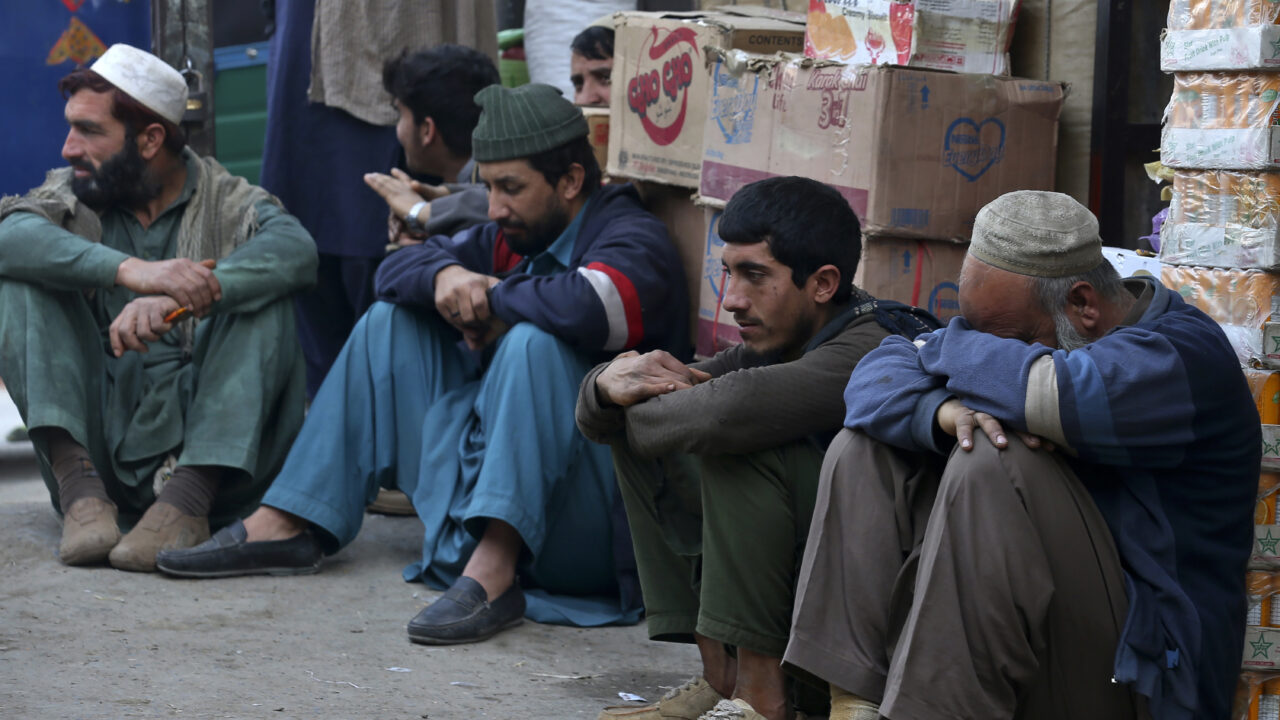Pakistan’s Mental Health Crisis
Generational tensions, plus a series of national catastrophes, have brought many youth to a breaking point. Daily wage laborers wait for work at a market in Peshawar, Pakistan, Feb. 17, 2023. Many laborers are worried how they will survive after the government advanced a bill to raise 170 billion rupees in tax revenue. That could worsen impoverished Pakistan's economic outlook as it struggles to recover from devastating summer floods and a wave of violence. (AP Photo / Muhammad Sajjad)
Daily wage laborers wait for work at a market in Peshawar, Pakistan, Feb. 17, 2023. Many laborers are worried how they will survive after the government advanced a bill to raise 170 billion rupees in tax revenue. That could worsen impoverished Pakistan's economic outlook as it struggles to recover from devastating summer floods and a wave of violence. (AP Photo / Muhammad Sajjad)
KARACHI, PAKISTAN — In July of 2021, a heinous crime committed in Islamabad, the federal capital of Pakistan, shook the country. A 30-year-old man from a well-connected business family raped and brutally beheaded his girlfriend while she was visiting him at his home. There was much speculation about what provoked Zahir Jaffer to murder Noor Mukaddam, the 27-year-old daughter of a former ambassador, in cold blood.
After police took Jaffer into custody, his parents and two bodyguards were also arrested on grounds of abetting and concealing the premeditated crime. Most significant was the alleged involvement of Therapyworks, a psychotherapy organization, in the incident. Its offices were initially sealed and three weeks later its CEO and five employees were arrested.
Jaffer’s connections with Therapyworks were of a personal-cum-professional nature. The CEO had been friendly with Jaffer’s parents. Several years ago, the CEO had suggested that Jaffer be treated for alcoholism, in response to his father’s request for advice. In 2015, the young man had gone to Therapyworks for training. Jaffer’s father was not in Islamabad when he learned of the tragedy. He requested that Therapyworks remove Jaffer from the scene of the crime.
Jaffer’s indictment raised the possibility of a death sentence, under national law. It was only when death stared Jaffer in the face that his lawyer demanded a mental health assessment of the accused. However, the request was dismissed when the prison doctor declared Jaffer sane. He was then sentenced to death., The parties are appealing and the case still has a long way to go. The parents and the Therapyworks employees were acquitted.
The Noor Mukaddam case has many implications for the mental health policy implementation and social culture in Pakistan, where awareness of mental health issues is growing, and discourse is emerging around the appropriate approach to handling these issues. Additionally, there are now debates about whether a person grappling with mental health issues can be held accountable for their actions, especially in legal matters.
Unfortunately, the stigma attached to mental illness still persists in Pakistan, to varying degrees, across castes, colors and creeds. For those without access to education, mental health issues do not have a medical reason. Some perceive an affected person as being possessed by evil spirits or under the spell of black magic; they visit shrines to pray to the saints or resort to physical punishment to exorcize evil spirits. But as education and awareness increase, particularly among the youth, the demand for modern mental health care (including counseling and psychiatrist-prescribed medications) is on the rise. With it has come the proliferation of spurious online counselors and quack psychiatrists.
The most immediate need is to de-stigmatize mental illness across Pakistan. Many young people who seek treatment would rather not disclose their problems to others, feeling it will affect their reputation. That discourages the use of group counseling on a wide scale. Many young people with mental health issues accept individual therapy only if they are assured anonymity.
Greater mental health awareness does not guarantee a sufficient understanding of the differences between issues of cognitive function and those of emotional stress stemming from socioeconomic factors. Only a mental health professional can distinguish between the two, as individuals have different psyches and responses to their environments.
Dr. Rahmat Kamal (a practicing psychiatrist until her retirement, whose name has been changed upon her request) says that mental health should be understood as a spectrum. “My experience tells me that the pendulum has swung to the other end,” she says. “The pathologization of mental illness has led to its commercialization as well. Everyone has an individual level of well-being needing a different approach.”
The most immediate need is to de-stigmatize mental illness across Pakistan.
Kamal feels that the conventional approach adopted worldwide is too dependent on pharmaceutical drugs when mental health can be improved by other means such as physical exercise, sensible counseling and various therapies recommended by the World Health Organization’s (WHO) Mental Health Gap Action Program, which was initiated in 2008. Its goal is to integrate mental health in the primary health care system of a country. It identifies areas such assuicide, depression, dementia and psychosis, and how they are being addressed successfully in participating countries.
“All the research in mental health, or any branch of medical science, is funded mostly by pharmaceutical companies which focus on the use of pharmaceutical drugs,” says Kamal. “They hardly study the impact of physical exercise on health and disease. This is something to ponder.”
In view of the above discourse, one might wonder about the main causes of the state of poor mental health among the youth in Pakistan. Among the major factors creating stress apart from the political and economic situation are the oppressive socio-cultural conditions that have, for decades, made life insecure for the marginalized. For those who live on the fringes, in terms of their faith, ethnicity, economic status, job and educational opportunities, life has always been a challenge. Add the natural or man-made calamities such as the earthquake in 2005, the floods in 2010, the COVID-19 pandemic and the floods again in 2022 and one begins to realize the extent to which Pakistanis are at risk.
The youth often seek relief on the internet, scrolling on social media and playing digital games, which can be addictive. Others have turned to drugs like tobacco and substances that contain betel nut and opium. Such self-prescribed treatments have now become a problem itself. There’s also rising use of heroin, pouring in from nearby Afghanistan, among youth.
Yousuf Nazar, former head of Citigroup’s Emerging Markets Investments, conveys the enormous challenges the country faces. “Pakistan’s present crisis is one of the worst in its history in political terms not only due to the polarized polity but also because the state is weaker and more fractured than it ever was,” he says.
In another article, “Pakistan’s Economy on the Brink”, Nazar identifies the economic problems: Pakistan’s foreign exchange reserves are falling sharply; heavy borrowing from abroad; a shortage of electricity for households and industry; low tax collection causing a budget deficit; and an inflation rate of 30% per year. He believes that the Pakistani state has never been so dysfunctional.
The state of the polity and the economy have only gotten worse since those articles were written several months ago. The youth have suffered the most. Unemployment and the declining state of the competitive education system have directly affected them. The government has lost its capacity to provide facilities for the youth bulge in these sectors.
Changing social norms are also a powerful cause of friction and tension between people, especially youth who tend to be impatient. The generation gap, gender inequality, the class divide, ethno-linguistic divisions and inter-faith intolerance create stress that can lead to behavioral problems. These challenges are not necessarily mental health issues, but do create stress.
In view of this, it is difficult to determine how many mental health professionals and facilities one needs for a populous country like Pakistan. There is no consensus either on rates of mental illness. Dr. Murad Moosa Khan, a psychiatrist of renown for his work with the World Health Organization on suicide prevention,estimates that 15%-20% of adults and 10% of children in Pakistan have some form of mental disorder. He says some studies quote an even more alarming number of 34%.
Among the major factors creating stress apart from the political and economic situation are the oppressive socio-cultural conditions that have, for decades, made life insecure for the marginalized.
WHO’s statistics put suicide and para-suicide figures in Pakistan at 130,000 to 270,000 every year.
The data issued by authorities on mental health facilities in the country are not reliable and appear to be insufficient. The National Human Rights Commission wrote to provincial health departments to provide the Commission with information on the number of registered mental health facilities. Sindh did not reply at all, while the others gave incomplete information. According to this source, there are 119 facilities in the country with the exception of Sindh. There are roughly 500 psychiatrists registered with the Pakistan Medical and Dental Council in this country of 231 million people.
Another factor impacting access to good care is the legal framework that governs the mental health care system in Pakistan. For decades, the obsolete Lunacy Act of 1912 introduced by the British colonial rulers was the main law regulating this sector. It was a long and consistent struggle by some psychiatrists and human rights defenders, led by Dr. Haroon Ahmed, that finally got the Lunacy Act replaced by the Mental Health Act in 2001. Haroon, now the patron of the Pakistan Association of Mental Health, is not satisfied with the state of implementation of the Mental Health Act.
“This is a good law,” he told me. “But to be effective it must be implemented efficiently by the Mental Health Authority. I am afraid the Mental Health Authority is not the most diligent of our institutions.”
* * *
One positive development is the rise of professionals and activists who are seeking to adopt a self-help approach for their communities. The Aga Khan University’s Brain and Mind Institute is working under the vision statement “Healthy Brain, Healthy World” to expand research in mental health and has adopted an integrated multidisciplinary approach. It also works on suicide prevention.
One remarkable self-help approach is the “Maraaka” (or consultation) that serves as an affordable suicide prevention strategy. Enayet, a mental health workIn June last year, Enayet mobilized some friends to organize a Maraaka. Nearly 700 young men and women and a few older people attended. Some of them shared their thoughts on suicide and then everyone was handed pen and paper to put down their thoughts on the issue. The responses were collected and analyzed by professionals, who then drew up a mental health plan. Enayet told me that holding such meetings have a positive impact as it allows those under stress an opportunity to vent their anger and frustration.er from Ghizr in Gilgit, told me that his native region has the highest rate of suicide in Pakistan among youth, primarily young girls, and that there was much concern about it. Trained in Karachi, he feels that the main cause of suicide in his home region is the rapidly growing education and empowerment of young women and men alongside a stagnant elder generation failing to keep pace. The youth are frustrated by this extremely conservative society, and generational tension is one result. The youth have sometimes responded to these challenges by throwing themselves into the river from the hilltop.
One positive development is the rise of professionals and activists who are seeking to adopt a self-help approach for their communities.
In June last year, Enayet mobilized some friends to organize a Maraaka. Nearly 700 young men and women and a few older people attended. Some of them shared their thoughts on suicide and then everyone was handed pen and paper to put down their thoughts on the issue. The responses were collected and analyzed by professionals, who then drew up a mental health plan. Enayet told me that holding such meetings have a positive impact as it allows those under stress an opportunity to vent their anger and frustration.
Enayet planned to hold such meetings in other sub-districts as well. The success of the Gizr Maraaka prompted the government to step in to take over the initiative. Enayet was pleased to be appointed a member of the officially constituted committee, as the main problem was a lack of funds to keep the project going.
But the initiative stalled. For months, the meeting of the committee was not called. Enayet even drew up a plan that he presented to the committee, but it remained a dead letter. Although he feels dejected, he has not given up all hope, and is now planning assemblies with youth and elders to foster harmony and communication between them.
In situations such as Pakistan’s growing mental health crisis, the solutions that work best are indigenous to those affected. People tend to view alien solutions with skepticism. The problem may be a global one, but the solutions must be local.
Your support is crucial...As we navigate an uncertain 2025, with a new administration questioning press freedoms, the risks are clear: our ability to report freely is under threat.
Your tax-deductible donation enables us to dig deeper, delivering fearless investigative reporting and analysis that exposes the reality beneath the headlines — without compromise.
Now is the time to take action. Stand with our courageous journalists. Donate today to protect a free press, uphold democracy and uncover the stories that need to be told.






You need to be a supporter to comment.
There are currently no responses to this article.
Be the first to respond.